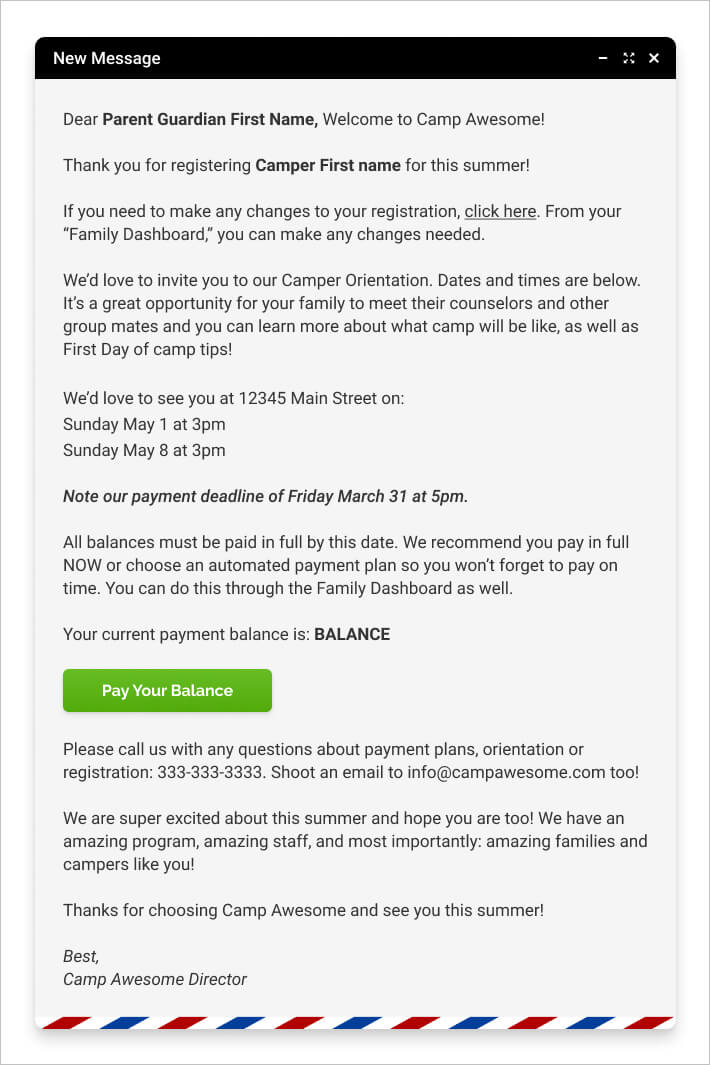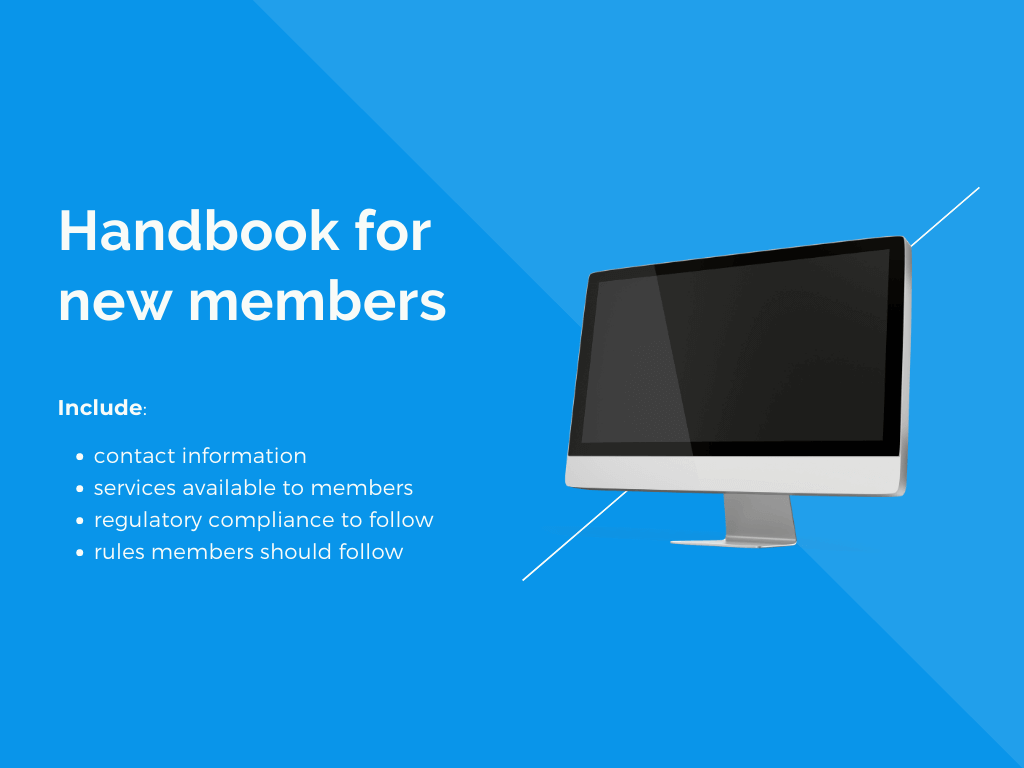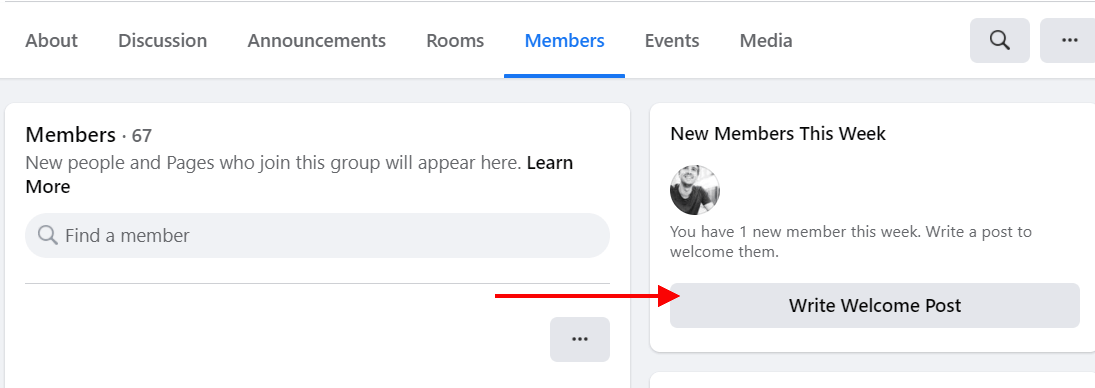If it’s your job to get people to subscribe to your event, online course, or camp, you’ve probably spent most of your energy devising ways to get your product in front of potential customers’ eyes.
But unfortunately, your work isn’t done after they click “Register.”
It’s imperative that you welcome new members in a way that keeps them excited and motivated to follow through on their journey with you.
That’s why in this article, we’ll give you twelve brilliant strategies for making your new members feel welcome and valued—which will translate into a higher participation and satisfaction rate for your product.
Let’s dive in!
Why It’s Important to Give New Members a Warm Welcome
You probably already know that customer service is an essential element in your brand’s success as a whole—but did you know that good customer service is important even before the consumer journey begins?
It’s true.
In fact, 84 percent of consumers consider customer service to be a key factor when deciding whether or not to even make a purchase.
In other words, a warm welcome is not just a good idea; it’s a survival tactic.
So when it comes to your event, online course, or membership product, you should start making your customers feel valued and heard from the word go.
No matter your event strategy or membership structure, it’s crucial to onboard new members with a friendly personal or virtual welcome.
Making new members feel welcome means that they’ll start off on the right foot and be primed to feel that their experience with you was satisfying and enjoyable rather than a chore to get through.
Taking the time to present a warm welcome shows that you respect the person—and it reminds them that you’re human, too.
Especially for online events and courses, it’s helpful to show that there’s a real live person (or, more likely, a group of people) on the other end.
That human connection and demonstration of mutual respect sets the stage and helps put your new members at ease right away.
1. Send a Personalized Welcome Email
The right membership management software solution will send an automatic confirmation email to welcome new members after the purchase is complete.
This welcome email should, at a bare minimum, thank the new member for joining the program and provide confirmation of payment.
However, to get the best results from this automated email, consider personalizing and boosting it with more useful content than a simple two-sentence thank-you note or receipt.

Emails are a powerful tool in all stages of the customer experience, from leading them through the marketing funnel to staying connected throughout their experience of your service or event.
Perhaps this is because it’s a direct line to the customer, and they have a direct line back to you simply by pressing “Reply.”
Take advantage of that direct line by sending a personalized message that makes them feel welcome.
That welcome email is not only expected in today’s digital age, but it comes with certain standards your new members will (even subconsciously) expect you to meet.
Here are a few tips on creating a personalized email:
- Personalized subject line: Start on a personal note by including the recipient’s name in the subject line of your message so that they feel personally welcomed before they even open the email
- Confirm their membership: Use a clear statement at the beginning of the message simply congratulating the recipient on joining your program, course, or group. For example, “Hi, [first name]! Welcome to [group]—we’re happy to have you. Here’s what happens next.”
- Don’t send a “noreply” email: While you might be tempted to limit the interactions you have with all of your members, setting your welcome email to “noreply” sends the signal that you’re difficult to get in touch with and that your organization doesn’t want to start a dialogue. That’s probably not the message you want to send.
- Stave off buyer’s remorse with social proof: Have you ever purchased a new course or membership, then immediately regretted spending that money? Validate your customers’ decision with a simple statement like, “Congratulations on joining 5,000 other industry professionals in becoming a part of [organization]!” After all, if 5,000 others found the offering useful, it must be worth it!
- Introduce them to their membership benefits: Send the details they need to get started (login details, subscription information, links to online resources about your offering, instructions on how to set their account) or give them access to whatever product you promised they’d receive upon signing up.
Make sure you adhere to these standards in your onboarding email to support your new members.
2. Create a Welcoming Video
Along with the introduction email, you should consider to make videos to welcome your new members. With Regpack, you can embed videos in a form to welcome new members and personalize your registration process.
The video should include general information about your course, group, or event.
Don’t get too bogged down in the details in your welcome video; your content should highlight the new member and the value your organization is about to provide to them.
You can also touch on your organization’s values, basic background, and anything else that you feel is important to share to give your new member a better idea of who you are and why you do what you do.
To create a welcome video that gets the best results, you can use a script or cue cards—but be conversational enough not to sound stilted or monotone.
Also, remember to make eye contact with your audience by looking into the webcam, not watching yourself on the screen, or staring at the script the whole time.
You should appear authentic, friendly, and welcoming—not overly formal or corporate.
3. Welcome New Members in the Company Newsletter
Does your organization offer a newsletter? It may be weekly, monthly, or quarterly—but if you have one, think about including a special shout-out to welcome new members.
Give them an official welcome by listing each new member by name.
However, to avoid confidentiality issues, consider listing their first name and the initial of their last name only.
During the onboarding process, you could also ask the new member how you should refer to them, since they may not want to be called by their legal name.
If your group or course has a limited number of people, you may want to take the newsletter introduction even further.
Send questionnaires to new members asking for a little relevant information about them (for instance, their occupation, general geographical location, or personal fun facts).
Use this information to craft little informational blurbs about new members in the newsletter so that established members can learn about their new peers and more easily welcome them into the fold.
No matter how much information you share, don’t forget to get consent from new members before sharing anything about them publicly within your group or organization.
Consider including a consent question in your onboarding or signup form, explaining when and how you’ll share their personal information.
4. Prepare an Onboarding Kit
When someone signs up for your program, course, or association, they probably have a million questions about what happens next.
They may have certain expectations of what their membership will be like—and it’s likely that they expect to start getting a bang for their buck right away.
Don’t give them the chance to be disappointed in your product! Send them a kit of useful resources and ways to get immersed in your product immediately.
It may include all the digital resources they’ll need to get started with you, such as:
- eBooks
- Handbooks (see tip #5)
- Learning materials
- Contact sheet with all the relevant contact emails
- Guide on how to use your software
While a typical welcome kit for virtual groups and online courses usually takes the form of an online archive, you can also opt for a physical one.
5. Share a Useful Handbook
Next, consider adding handbooks to your onboarding welcome experience.
Especially if the product you’re offering is a course, new members can benefit from a handbook detailing the course content, how it is delivered, and how the students can succeed in meeting expectations or passing assessment milestones.
Your handbook should contain all useful reference information that you can think of, such as:
- Contact information
- The services available to members
- Any regulatory compliance that your organization follows
- The rules or regulations your members are expected to conform to
Think of your handbook as the main information source about your product. What kinds of things should your customers know in order to interact with your offering successfully?

If you offer a variety of courses or products, you may want to have different handbooks for each one.
That way, each handbook is unique to the product at hand and contains relevant information.
Another option is to offer a generic handbook across all of your products, which may be preferable to you if each of your products shares similar content, rules, or contexts.
6. Personalize Their Welcome With Milestones
A milestone is simply a specific point along a timeline, which, once reached, can be celebrated or rewarded. These milestones inspire goals and set up achievements to come.
When onboarding, milestones will be anything that helps your new members feel that they are making progress.
These milestones might be:
- Creating an account in your member area
- Downloading your handbook or reference materials
- Starting the first module of your course
You may also simply show them the milestones you’ve already created as regular benchmarks along your program journey (such as modules in your course or the timeline leading up to your event).
Using a bright, colorful infographic that outlines their upcoming journey will help them orient themselves and get excited for the process to come.
7. Send Them Some Swag
What says “we’re glad you’ve joined us” better than a branded gift delivered to your doorstep?
While digital welcome techniques can be extremely effective, there’s just something special about receiving a physical token.
It sends the message that your organization doesn’t hesitate to spend the time and resources to design, purchase, and physically mail items to the new member’s home.
After all, your customers know that welcome emails can be automated, but physical mail is less easy to set-and-forget.
Of course, if you do decide to send new members some swag, be careful to send the right thing.

Branded t-shirts are an example of good swag
Simply mailing off a bag of cheap branded pens and a mousepad may not give the impression of thoughtfulness and care that you intended.
While you don’t have to break the bank, keep your focus on those items that your customers will actually use, and that others will see them use—think of all that free advertising!
Affordable but useful branded items include:
- Magnets
- Stickers and window decals
- Keychains and lanyards
- Mugs and tumblers
- Water bottles
- Tote bags
Don’t forget that a swag bag is a perfect place to include informational packets, as well.
Toss in a welcome brochure, a hard copy of your handbook, or any other resource that you think your new member will find useful.
8. Give Them Gift Cards
Speaking of gifts, you can also give away more welcome perks in the form of a gift card. Providing access to free or discounted content helps your new members feel valued.
Send a gift card or discount for your company’s services, or you even consider sending gift cards from one of your partner brands.
Producing physical gift cards comes with a price tag, so you can always opt for digital ones. You might simply send a discount code, voucher, or rebate offer via email instead.
Use vouchers or download codes based on your new members’ personal interests to make an even better impression.
You may want to include questions in their signup forms to help you navigate their interests; or, you could send a certain gift card based on the type of product or membership type they signed up for.
9. Onboard New Members with a Mentor
Another great way to welcome new members is to assign them a mentor, or someone who can personally assist them in adjusting to your program or service.
Traditional onboarding programs often focus on bombarding the new member with information, paperwork, and impersonal processes. Strive to solve that problem by introducing a uniquely human element.
In workplaces, employers often use the mentor-mentee system to help new hires adjust to the new workplace.
Mentorship helps employees integrate into the organization more seamlessly while giving management real-time access to information on new-hire satisfaction.
Essentially, you get feedback about the company from fresh eyes.
Why not use the same approach for your program?
Whether it be a course, a membership association, or a seminar or other event, your program could benefit from the added human element that mentorship can provide.
Of course, you may not have the framework or staff size to assign a mentor to each new member in the traditional sense.
However, there are a few ways to use the mentorship model to help onboard new members.
For instance, you might divide new members among members of your team, who reach out with personalized templates to introduce themselves, give virtual tours of the program’s features, and offer to answer any questions the member has.
Your staff can use this approach with individuals, or they can let the new members know that they are part of a cohort being mentored as a group.
The latter method invites inter-group collaboration and bonding, which is an added bonus.
If you offer an online course, you could use the same approach but with previous course students as mentors.
They can send an introductory email or video to the new course members, giving their personal impression of the benefits of the course and inviting questions.
Using a mentor figure in this context can help break the ice among new course students.
10. Connect Them With an Online Buddy
If you’re struggling to work mentorship into your current framework, another option is to use a buddy system as part of your member onboarding process.
After all, your new members will likely still have questions even after the most thorough onboarding process.
Going the extra mile by assigning an online “buddy” from among their peers will help make sure they feel connected and welcome as they begin their journey with your product or course.
Using the buddy system by pairing a more experienced member with a new member helps integrate the new member without making them feel like they’re being chaperoned.
The experienced member can simply check in periodically after the initial introductory phase, making sure the new member is adjusting well and isn’t struggling with any aspects of your product or course.
Especially if you’re offering an online course, it can be difficult for students to feel connected to the larger group.
Using a “study buddy” system can help them build stronger bonds with their classmates (which leads to a greater sense of community and purpose within the larger class).
Study buddies can provide peer review, task management assistance, and motivation—all things that are hard to come by in an online setting.
11. Highlight New Members in Your Organization’s Facebook Group
If you don’t have a Facebook group for your event, product, or course, you should seriously consider starting one.
Facebook groups are a free way to engage with the platform’s 2.41 billion active monthly users and build long-lasting relationships with your customers.
A Facebook group can also be a great tool for community-building and helping new members feel welcome right away.
Once a new member joins your organization, prompt them to join your Facebook group.
Depending on how frequently you get new members, you may want to create a welcome post for each individual member—or simply create weekly posts to welcome the new members that have joined that week.

If it feels appropriate, tag them by name. If not, simply post a generic welcome message.
Either way, invite newcomers to introduce themselves in the comments and ask the community to join together in welcoming new members to the group.
Encourage your group administrators to join in on the welcome posts as well, introducing themselves in the comments and saying a quick hello to newcomers.
This simple act helps acknowledge new members and orient them to the structure of the group.
12. Use Discussion Forums
Finally, don’t forget about the power of discussion forums!
If you’re teaching an online class, use discussion boards and forums in your onboarding process.
Allowing new students to interact with their teaching staff and with each other in a low-stakes, informal environment is a great way to break the ice.
Introduce yourself to get the ball rolling, then set the guidelines for the discussion. Make sure it’s clear that the purpose of the discussion thread is simply to get to know one another.
Perhaps you could ask conversation-starters, such as:
- Where are you located?
- What’s your job title, and what is your favorite thing about your job?
- What do you hope to get out of this course?
- What is your favorite hobby?
- Do you have any pets? If so, feel free to upload a picture!
Make it clear that participation in the discussion isn’t mandatory, but it is encouraged.
Some members will be more eager than others to share about and discuss each other’s lives, while others will be content to simply read through everyone’s comments and get a feel for the group they’ve joined.
Both methods are completely fine and serve to build a sense of community among your students.
Welcome New Members by Getting them Engaged and Excited
After a customer purchases a membership to your event, course, or product, it’s essential to make them feel as welcomed and valued as possible.
As businesses, it’s easy to focus on turning leads into customers—but without a warm welcome, you risk your new members losing interest before they can take full advantage of their membership.
In order to welcome new members the right way, take advantage of the technology at your fingertips.
Use personalized emails, welcome videos, newsletter shoutouts, and gifts (both digital and physical) to help your new members feel seen and appreciated.
You won’t regret going the extra mile once that new member has become a loyal customer for life!


















